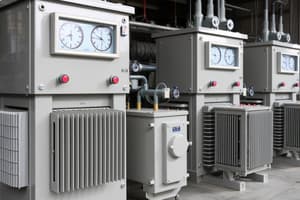Podcast
Questions and Answers
With respect to the double-wound transformer, what is a major disadvantage of an auto-transformer?
With respect to the double-wound transformer, what is a major disadvantage of an auto-transformer?
- Auto-transformers present a high risk to both people and equipment when stepping down a high voltage to a low voltage (correct)
- Auto-transformer voltage regulation is poor
- Auto-transformer efficiency is the lowest of all the transformer types
- Auto-transformers have much higher copper loss
What are FOUR major advantages of auto-transformers? (Select one or more)
What are FOUR major advantages of auto-transformers? (Select one or more)
- They are useful for high voltage changes (correct)
- They work on both AC and DC
- They have better voltage regulation and operate at a higher efficiency than a 2-winding transformer of the same rating (correct)
- They have a larger short circuit current
- They require a smaller magnetising current than a 2-winding transformer of the same rating (correct)
- They are safer than most other transformers
- They have a smaller size than an ordinary transformer of the same rating (correct)
- They require less copper than an ordinary transformer of a similar rating (correct)
The primary of a potential/instrument transformer is connected:
The primary of a potential/instrument transformer is connected:
- In parallel with the supply (correct)
- On top of each other
- In series with the supply
- In order of size
To ensure safe removal of a current transformer you must:
To ensure safe removal of a current transformer you must:
Determine the actual values of voltage and current that would be applied to the meters if the line voltage was 10,950V and the line current was 140A.
Determine the actual values of voltage and current that would be applied to the meters if the line voltage was 10,950V and the line current was 140A.
A current transformer is a type of instrument transformer. What is a current transformer most commonly used for?
A current transformer is a type of instrument transformer. What is a current transformer most commonly used for?
Instrument transformers are used in test laboratories.
Instrument transformers are used in test laboratories.
The core of a current transformer is typically:
The core of a current transformer is typically:
In installing a current transformer, what TWO circuit components are connected in series with the CT primary conductor? (Select one or more)
In installing a current transformer, what TWO circuit components are connected in series with the CT primary conductor? (Select one or more)
What does a rating of 300:5 mean in relation to a current transformer?
What does a rating of 300:5 mean in relation to a current transformer?
A load connected to a three-phase, three-wire 11,000/415 V line-to-line potential requires measurement. It is estimated to be 3000 kVA. What type of CT and PT are suitable?
A load connected to a three-phase, three-wire 11,000/415 V line-to-line potential requires measurement. It is estimated to be 3000 kVA. What type of CT and PT are suitable?
A 1000kVA load is supplied from a three-phase four-wire 11,000 V line. What type of CT and PT are suitable?
A 1000kVA load is supplied from a three-phase four-wire 11,000 V line. What type of CT and PT are suitable?
Flashcards are hidden until you start studying
Study Notes
Auto-transformers
- Higher copper loss is a major disadvantage compared to double-wound transformers.
- Auto-transformers require less copper than ordinary transformers, making them more efficient.
- Suitable for high voltage applications, they enhance safety, consume less magnetising current, and operate with better voltage regulation.
Instrument Transformers
- Potential transformers are connected in parallel with the supply to measure voltage accurately.
- Current transformers (CTs) are primarily used for metering purposes in electrical systems, enabling safe measurement of high currents.
- Safety measures include shorting the secondary winding for safe removal of a current transformer during maintenance.
Technical Specifications
- A 300:5 rating in current transformers indicates that when 300 amps flow through the primary winding, 5 amps will be produced in the secondary circuit.
- Common configurations involve series connections of load supply cable and the load itself with the primary conductor of a CT.
Questions & Answers Overview
- Correct identification of voltage and current values in transformer setups shows effective understanding; for example, a line voltage of 10,950V translates to monitoring values of 109.5V and 3.5A.
- For a three-phase 11,000V line supplying a 3000 kVA load, appropriate transformers must be selected; a suitable combination is a current transformer with a 200:5 ratio and a potential transformer with a 100:1 ratio.
Practical Applications
- Instrument transformers are vital in testing laboratories to create safe test environments while dealing with high voltage systems.
- Select transformers based on specific load requirements and ensure precise metering by matching ratios according to intended usage (e.g., 75:5 ratio for a 1000 kVA load).
Studying That Suits You
Use AI to generate personalized quizzes and flashcards to suit your learning preferences.




